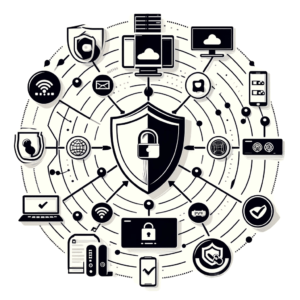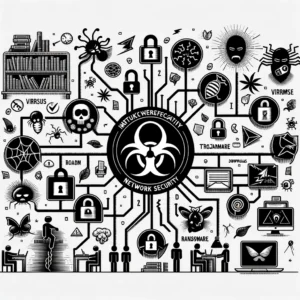Understanding Network Security

In today’s world of technology, it’s crucial to have strong security practices to keep your network and the data it holds safe. Network security is all about preventing unauthorized access and cyber attacks on your computer system. By implementing security measures, organizations can protect their important information and ensure their systems stay safe and reliable.
One important way to improve network security is by using firewalls. Firewalls help protect a trusted internal network from potentially dangerous external networks by filtering incoming and outgoing traffic based on security rules. Another way to ensure secure communication is by using virtual private networks (VPNs) to encrypt data sent over a network, especially for remote users.
In addition, using strong security measures like multi-factor authentication (MFA) can make your accounts even safer. This requires you to verify your identity in more than one way. It’s also important to keep your software up to date and fix any holes in the system, as old software can leave your network open to cyber attacks.
By understanding the importance of network security protocols and implementing effective measures, organizations can mitigate cybersecurity risks and safeguard their networks against malicious activities.
Importance of Robust Network Protocols
Having strong network protocols in place is really important for keeping our network running smoothly and protecting our information. When our devices can communicate effectively and securely using these protocols, we reduce the chances of hackers gaining access to our data or causing problems on our network. It’s all about making sure our technology is safe and reliable.
Well-designed network protocols are essential for improving network efficiency and reducing network congestion. When implemented correctly, these protocols can optimize data transmission, streamline network traffic, and enhance overall performance. Furthermore, by establishing standardized communication methods, robust protocols facilitate seamless connectivity between different systems and devices, promoting interoperability and compatibility.
In order to protect important information and fend off cyber threats, it is crucial to have strong network protocols in place. These protocols use special security measures like encryption and authentication to keep data safe both when it’s being sent and when it’s stored. By making sure that all communication on a network is secure, organizations can strengthen their defenses and prevent cyber attacks.
In conclusion, prioritizing robust network protocols is essential for maintaining a resilient network infrastructure and safeguarding against potential cybersecurity risks. By implementing effective protocols, organizations can enhance their network reliability, performance, and security posture.
Common Threats and Vulnerabilities
When setting up protocols to make your network and data more secure, it’s important to know about common threats. One of the biggest dangers is malware, such as viruses, worms, Trojan horses, and ransomware. These harmful programs can get into your network through email attachments, downloads, or software that isn’t up to date. Once they’re in, they can steal important information and cause a lot of problems.
Another big risk is having weak security measures for verifying people’s identities and controlling who can access certain information. If there aren’t strong enough methods for confirming someone’s identity, hackers can get into important data, causing security breaches and other problems. Also, if the network setup isn’t secure, it can give hackers ways to break in and mess with everything.
Phishing attacks are a serious threat to network security. Cybercriminals pretend to be trustworthy sources to trick people into sharing private information. But organizations can lower the risk of falling for these scams by educating employees and providing proper training.
Overall, staying informed about common threats and vulnerabilities and implementing proactive security measures are essential steps in safeguarding networks against cyber threats and ensuring overall network security.
Issues in Current Network Protocols
When it comes to implementing effective protocols for improved network and network security, understanding the issues in current network protocols is crucial. One of the major challenges faced by organizations today is the susceptibility of outdated protocols to cyber threats and attacks. Many legacy protocols lack robust security measures, making them vulnerable to breaches and unauthorized access.
Another issue in current network protocols is the lack of encryption and authentication mechanisms, leaving sensitive data exposed to potential interception and manipulation. Additionally, ineffective routing protocols can lead to network congestion and inefficiencies, impacting the overall performance and reliability of the network.
To address these issues and enhance network security, organizations must prioritize the adoption of modern and secure protocols such as TLS, IPsec, and DNSSEC. These protocols provide encryption, authentication, and integrity mechanisms to safeguard data transmission and reduce the risks of cyber threats. By implementing effective protocols, organizations can strengthen their network defenses and mitigate potential security vulnerabilities.
Effective Network Security Protocols
When creating a safe network, it’s important to think about some important things. Firstly, use protocols with strong encryption to protect your data from hackers. Additionally, use protocols that have ways to confirm users and devices, so only authorized people can access the network.
Another important feature of robust protocols is error detection and correction capabilities. This allows for the detection and mitigation of data transmission errors, ensuring the integrity of the data being transmitted. Furthermore, protocols should be designed to be efficient and optimized for network performance, minimizing latency and ensuring smooth communication between devices.
Scalability is important for protocols to handle more users and devices, without losing speed or security. It’s also essential for protocols to have good tracking and monitoring to find any unusual behavior that could hint at a security problem.
Examples of Effective Protocols
When it comes to implementing effective protocols for improved network and network security, there are several key protocols that organizations should consider incorporating into their infrastructure. One such protocol is the Secure Socket Layer (SSL) protocol, which helps to establish a secure connection between a user’s browser and a website, ensuring that data exchanged is encrypted and secure. Another crucial protocol is the Hypertext Transfer Protocol Secure (HTTPS), which encrypts data transmitted between a user’s browser and a website, protecting sensitive information from unauthorized access.
Additionally, the Internet Protocol Security (IPsec) protocol helps to secure communication over a network by authenticating and encrypting each data packet transferred. Another effective protocol is the Simple Network Management Protocol (SNMP), which allows network devices to communicate and exchange information for centralized monitoring and management.
By using these and other helpful methods in their network systems, companies can improve their network security and prevent cyber threats and attacks.
Implementing Security Protocols for Better Network Security
Implementing effective security protocols is crucial for ensuring the protection of your network and enhancing overall network security. By following a strategic approach, you can establish a robust framework that safeguards sensitive data and mitigates potential security risks.
The first step in protecting your information and systems is to assess any potential risks. This means looking for weaknesses and figuring out how much security you need. By doing this, you can better understand the specific dangers your network might face and decide what to focus on to keep it safe.
Once we have assessed the risks, the next step is to create a security policy that outlines the specific rules and procedures that should be followed to keep our information safe. This policy will include guidelines for controlling who has access to our data, encrypting our information, and responding to any security incidents promptly to make sure we are staying ahead of potential threats.
After creating the security plan, the next important step is to put in place security measures like firewalls, intrusion detection systems, and tools for watching over the network. These tools help you keep an eye on what’s happening in your network, spot any potential dangers, and quickly deal with any security issues.
Having regular training sessions and awareness programs for employees is important to make sure that our security measures work well. When we teach our staff about the best ways to stay safe and the things that could put us at risk, we can build a strong sense of security within our organization.
Challenges in Implementation and their Countermeasures
Implementing effective protocols for improved network and network security comes with its own set of challenges. One common challenge is the complexity of setting up and maintaining multiple security protocols on various network devices. This could lead to misconfigurations and vulnerabilities if not managed properly. To counter this challenge, organizations should invest in centralized management tools and automation technologies to streamline the implementation process and ensure consistency across all devices.
Another challenge is ensuring compatibility and interoperability between different protocols and devices within the network. Without proper integration, there can be gaps in security coverage and potential vulnerabilities. To address this, organizations should conduct thorough compatibility testing before deployment and implement protocols that are widely supported by different vendors.
Moreover, the challenge of scalability and flexibility arises as networks grow and evolve. It can be difficult to adapt security protocols to accommodate changing network infrastructures. Organizations should plan for scalability from the outset, choosing protocols that can easily scale with the network and implementing regular audits and updates to ensure continued effectiveness.
Conclusion
When it comes to implementing effective protocols for improved network and network security, a crucial aspect is the continuous review and enhancement of protocols. Regularly reviewing protocols ensures that they align with the latest cybersecurity best practices and standards, helping to mitigate potential vulnerabilities and security risks. By proactively identifying weaknesses in existing protocols through comprehensive reviews, organizations can strengthen their network defenses and safeguard sensitive data from cyber threats.
It’s really important to keep updating protocols to keep up with changes in cybersecurity threats and challenges. When we’re proactive in making these updates, it helps us stay ahead of cyber attackers and decrease the chance of them successfully breaching our system. Updating protocols also helps us stay in line with rules and standards, which shows that we’re serious about keeping our network safe.
In conclusion, the role of continuous protocol review and enhancement is paramount in establishing robust network security measures. By prioritizing regular reviews and proactive enhancements, organizations can fortify their defense mechanisms and effectively protect their network assets from cyber threats.
